University of Wisconsin-Madison
Since 1892 dailycardinal.com
Thursday, September 21, 2023 l
REVENGE ON THE ROAD
+ SPORTS, PAGE 7 + NEWS, PAGE

+ SPORTS, PAGE 7 + NEWS, PAGE
from trying to from filing a lawsuit,” Velasquez said. “But we are really confident that the two courts that have looked at the statute, since Roe and now one since Dobbs, have both said the statute does not apply to abortion.”
Assembly Speaker Robin Vos, R-Rochester, told reporters on Sept. 14 that outside groups may sue but that the Legislature does not “have to put itself into every single legal argument.”
Instead, Vos said he would pray for the “unborn children who won’t have the opportunity to be born.”

University Health Services (UHS) plans to once again refer University of Wisconsin-Madison students to in-state clinics for abortion services amid a recent shakeup in interpretations of Wisconsin abortion laws, a UHS representative told The Daily Cardinal on Monday.
Sarah Clifford Glapa, UHS associate director of marketing and health communications, said in an email that Planned Parenthood of Wisconsin’s (PPWI) recent decision to restore abortion services to two Wisconsin health clinics increases “local access to care for students,” including abortion referrals.
“University Health Services remains dedicated to providing a spectrum of gynecology services to our students, including contraception consultations, as well as abortion referrals and follow-up for health care services UHS does not provide,” Clifford Glapa told the Cardinal.
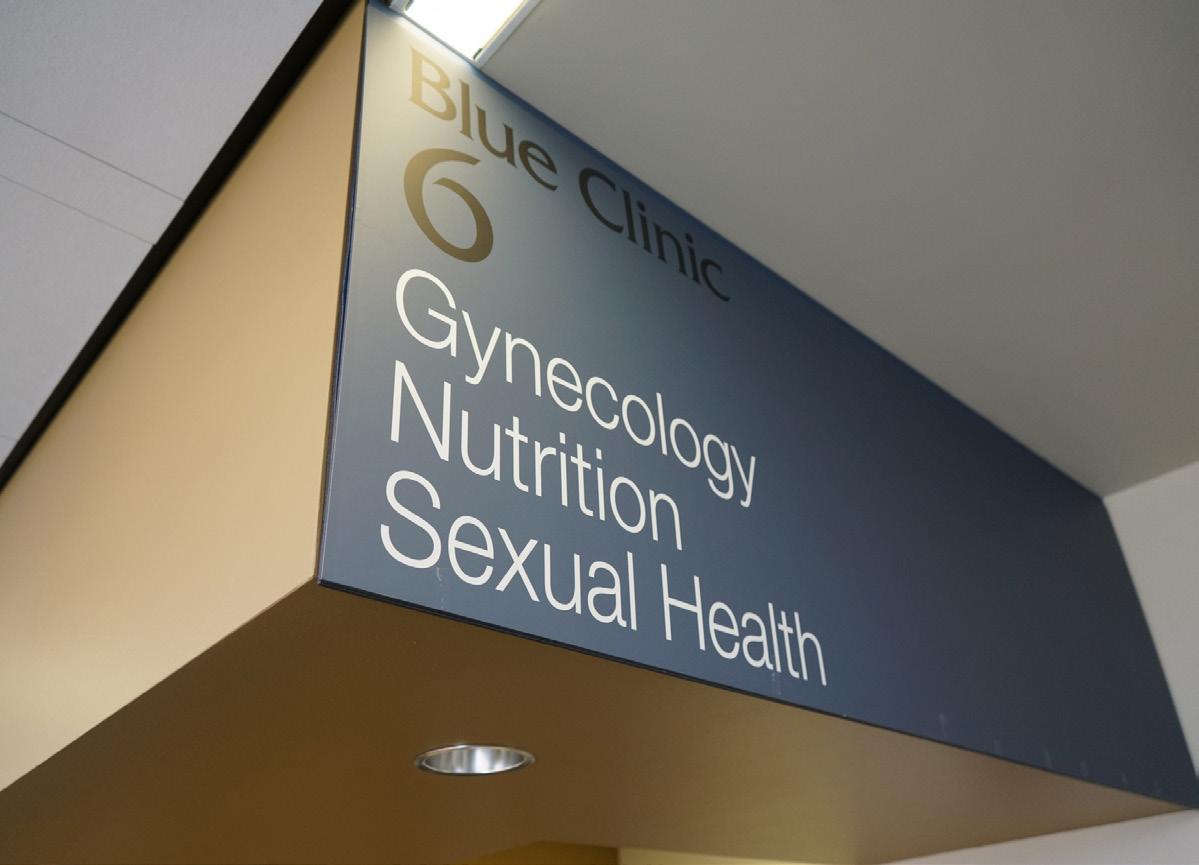
UHS previously referred students to abortion services at instate clinics, but required to refer students out-of-state in June of last year due to an 1849 Wisconsin law that until recently was interpreted as a near-total ban on abortions in the state.
Recent court ruling prompted decision to resume abortions
Planned Parenthood’s decision to restore abortion services at its Water Street Health Center in Milwaukee and its Madison East Health Center revived legal and medical debates surrounding abortion, particularly about Wisconsin’s 1849 abortion law.
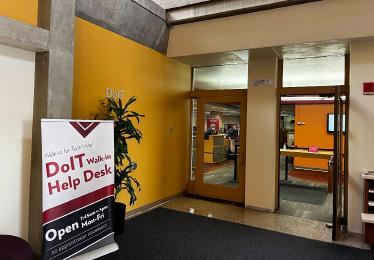
The law, reinstated after the U.S. Supreme Court overturned feder-
ally guaranteed abortion rights in 2022 with its Dobbs v. Jackson Women’s Health Organization ruling, banned nearly all abortions with no exception for rape or incest.
Wisconsin Attorney General Josh Kaul filed a lawsuit in Dane County challenging the law days after the Dobbs decision.
Planned Parenthood cited a recent ruling from Diane Schlipper, a Dane County circuit court judge, in its decision to resume abortion services.
Schlipper ruled in July that the 1849 law’s language does not prohibit consensual medical abortions and only forbids an individual from attacking a woman with an attempt to kill her developing fetus.
“There is no such thing as an ‘1849 abortion ban’ in Wisconsin. A physician who performs a consensual medical abortion commits a crime only after the fetus or unborn child reaches viability,” Schlipper said in her decision.
Michelle Velasquez, director of legal advocacy services at PPWI, said Planned Parenthood suspended abortion services after Dobbs v. Jackson because “we knew that there was a real threat or real risk to physicians and clinicians and other health center staff.”
PPWI sought clarification that the 1849 law was no longer enforceable, a goal achieved through Schlipper’s ruling in July.
“There is no 1849 criminal abortion ban in Wisconsin. And so that’s really the confirmation that Planned Parenthood Wisconsin needed to resume services that there is no enforceable abortion ban in Wisconsin,” Velasquez told The Daily Cardinal.
But as matters evolve, Velasquez said abortions may still be prosecuted under the 1849 statute.
“We can never stop somebody
Women seek medical abortions for a variety of reasons. They may find themselves making this choice when their life is in jeopardy, to prevent a pregnancy caused by rape or incest, to avert the birth of a fetus with a significant genetic deformity or avoid childbirth due to economic factors, according to the National Library of Medicine. Restricting access to abortions does not reduce the number of abortions but rather reduces the safety of the procedure, according to the World Health Organization. WHO statistics show between approximately 5% and 13% of maternal deaths each year can be attributed to unsafe abortions.
Furthermore, most women discover they are pregnant between four and seven weeks.
And at the time of Roe v. Wade, the Supreme Court wrote that viability is placed at between 2428 weeks. Over 90% of abortions occur before 13 weeks gestation while 1.2% of abortions are performed at or after 21 weeks, according to Centers for Disease Control and Prevention data.
Abortions that occur during a later stage are rare and are often life-threatening to the woman, according to the Kaiser Family Foundation.
Velasquez explained that restricting medical abortion access is “felt most by marginalized communities, specifically the Black and Indigenous communities that face worse health outcomes.”
“Maternal and infant mortality rates are higher in those communities than any other and so when there’s a lack of access to abortion care, there’s also just generally [a] lack of access to women’s health care,” she said.
Continue reading @ dailycardinal.com
A faulty server caused four days of Wi-Fi outages for the University of WisconsinMadison’s “UWNet” network, which is now stable after repairs.
Starting on the morning of Monday, Sept. 11 through Wednesday, Sept. 13, the network allowed users to connect but had no internet during high usage periods on campus. The outage came during the first full week of fall semester classes, with students and faculty saying their ability to complete coursework was heavily impeded
UWNet was also briefly down during the afternoon on Sept. 14 but functioned normally the rest of the day, according to the UW-Madison Division of Information Technology (DoIT). The outage came during the first full week of fall semester classes.
Most wired connections on campus, such as library computer labs or department-specific connections were unaffected, according to DoIT. However, many residence halls were impacted by the lack of internet.
“I couldn’t connect at all for three days,” said Charlotte Wood, a freshman and Slichter Residence Hall resident. “Allegedly, it was spotty coverage, but I just had no coverage. My phone plan does not have a hotspot so I had to buy Starbucks and hang out there for hours and bang out my homework… some of my classmates went to Buffalo Wild Wings.”
Some students and instructors relied on accommodations and extensions for classwork as students depend on the internet to complete and submit assignments.

“I got an email right away that said a deadline was being pushed back,” said Ellys Roberts, a freshman and Dejope Residence Hall resident. “My other teachers only mentioned the outages, but they never pushed back deadlines or accommodated students.”
DoIT staff and engineers from UW-Madison’s internet provider
worked throughout the outages to try and find the source of the issue. Although they first thought the outage was caused by a software bug in vendor products used for on-campus Wi-Fi service, they eventually located a faulty server on campus.
“By Wednesday evening, the vendor analysis showed that our situation was in fact not a bug in the software supplied by our wireless vendor,” DoIT said in a statement. “[It] instead pointed to a server on the UW-Madison campus that was acting problematic.”
UW-Madison computer science professor and computer network scholar Paul Barford said he believed that one of the university’s servers had an issue interpreting IP addresses — the string of characters that identifies devices trying to connect to a network.
“My understanding was that the server that was responsible for passing out those IP addresses had a problem. Once they were able to fix that problem with the server, everything was up and running shortly thereafter,” Barford said.
Barford also discussed the reliability of the internet in general and on campus. He said engineers work to create redundancies so that the internet will work even if a part of the network malfunctions.
“Every so often, we experience something like what happened last week,” Barford said. “In all of my time at UW-Madison, which is more than 20 years, we’ve never had anything like what happened last week, so it is a very, very unusual event.”
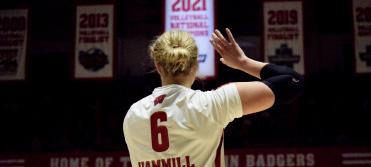
According to DoIT outages reports records, multi-day outages occurred in both the fall of 2017 and 2021.
DoIT clarified in an email to all students during the outage that there was no evidence to suggest a cybersecurity threat. They also plan to implement changes to their “alerting instrumentation” to detect problematic servers earlier and to install new hardware for a more “resilient campus wireless network.”
“…the great state University of Wisconsin should ever encourage that continual and fearless sifting and winnowing by which alone the truth can be found.”
Copy Editors Kodie Engst • Ella Gorodetzky
Ian Wilder • Jackson Wyatt
Social Media Manager Rachel Schultz
Business and Advertising
business@dailycardinal.com
Business Manager Emily Chin
Advertising Manager
Samuel Mayo Marketing Director Claire Taylor
The Daily Cardinal is a nonprofit organization run by its staff members and elected editors. It receives no funds from the university. Operating revenue is generated from advertising and subscription sales. The Daily Cardinal is published weekdays and distributed at the University of WisconsinMadison and its surrounding community with a circulation of 10,000.
Capital Newspapers, Inc. is the Cardinal’s printer. The Daily Cardinal is printed on recycled paper. The Cardinal is a member of the Associated Collegiate Press and the Wisconsin Newspaper Association.
All copy, photographs and graphics appearing in The Daily Cardinal are the sole property of the Cardinal and may not be reproduced without written permission of the editor in chief.
The Daily Cardinal accepts advertising representing a wide range of views. This acceptance does not imply agreement with the views expressed. The Cardinal reserves the right to reject advertisements judged offensive based on imagery, wording or both.

Complaints: News and editorial complaints should be presented to the editor in chief. Business and advertising complaints should be presented to the business manager.
Letters Policy: Letters must be word processed and must include contact information. No anonymous letters will be printed. All letters to the editor will be printed at the discretion of The Daily Cardinal. Letters may be sent to opinion@ dailycardinal.com.
Editorial Board
Graham Brown • Tyler Katzenberger
• Em-J Krigsman • Charlotte Relac •
Priyanka Vasavan • Drake White-Bergey • Ethan Wollins
Board of Directors
Scott Girard, President
Hurricane Hilary’s wreckage led to the relocation of 20 dogs from Riverside County, California, to Dane County on Sept. 14 following the closure of an animal shelter.

German Shepherds, Siberian Huskies and mixed breeds were transported by Wings of Rescue, a nonprofit organization focused on reducing euthanasia rates by transferring dogs from overcrowded shelters to less crowded ones.
Dane County Humane Society (DCHS) previously provided relief for shelters that experienced overcrowding around the nation. In April, DCHS received 24 cats from Texas. In February 2022, DCHS took in 60 dogs from overcrowded shelters from Louisiana.
This transportation came at a crucial time as Hurricane Hilary exacerbated overcrowding conditions, often leaving shelters inaccessible to the general public.
“It looked like a lake out there, and it was blocking access to our facilities,” Kerri Mabee, Riverside County Department of Animal Services spokesperson, told The Daily Cardinal.
Additionally, Mabee believes “most shelters across the United States are experiencing overcrowding” right now.
Lisa Bernard, DCHS public relations coordinator, told the Cardinal larger dogs can be difficult to house compared to smaller animals due to weight, breed and apartment size dissuading potential adopters.
“People live in different residences — apartment buildings and such — that have restrictions on size and weight,” Bernard said. “Some prefer smaller dogs to larger dogs because they think they’ll be able to handle them better.”
Despite these challenges, Bernard has hope that all of the dogs will be adopted, believing “we have a very loving community” in Dane County that “loves their animals.”
In light of this, 11 of the dogs have already been adopted and another is currently on hold, according to DCHS. The animals are not at risk of being euthanized while still healthy thanks to DCHS policy.
“The number of adopters in our community is much higher than the number of animals that are surrendered or who come in stray and don’t find their families with them,” she noted.
Though overcrowding remains a major problem across the nation, particularly in warmer climates such as the South and Los Angeles,
Dane County has maintained a manageable animal population, Bernard said. The bitter cold of Wisconsin’s winters provides relief to Wisconsin’s Humane Societies by restricting the breeding season and slowing the spread of viruses among animals, he added.
The high adoption rate couldn’t be done without foster adopters, animal behavior specialists and the 900 volunteers who work for DCHS, Bernard said.
“We’re always thinking of ways to help the animal mentally as well as emotionally,” she said. “We don’t just focus on the physical.”
In addition, DCHS has a rehoming service on their website where new owners can adopt pets directly from their old owners, limiting an extended stay at the
humane society.
Bernard highlighted the importance of getting animals spayed and neutered to prevent the overcrowding of animal shelters.
“I don’t think there’s just one answer,” she said. “We need more veterinarians to go to school and we can offer more services and make sure these animals are getting spayed and neutered.”
DCHS also holds events such as Dog Days, where pet owners bring their dogs to receive pet supplies and vouchers to get their pets spayed or neutered for free.
“We feel great relief, great happiness and a huge amount of gratitude to Dane County and all of our partners, including Wings of Rescue, who came together to do this great deed,” Mabee said.
Members of the Madison community, including Chancellor Jennifer Mnookin, emphasized the necessity and crucial role of free speech and diversity, equity and inclusion (DEI) on campus in a panel Tuesday evening amid student discontent with the University of Wisconsin-Madison’s free speech policies.
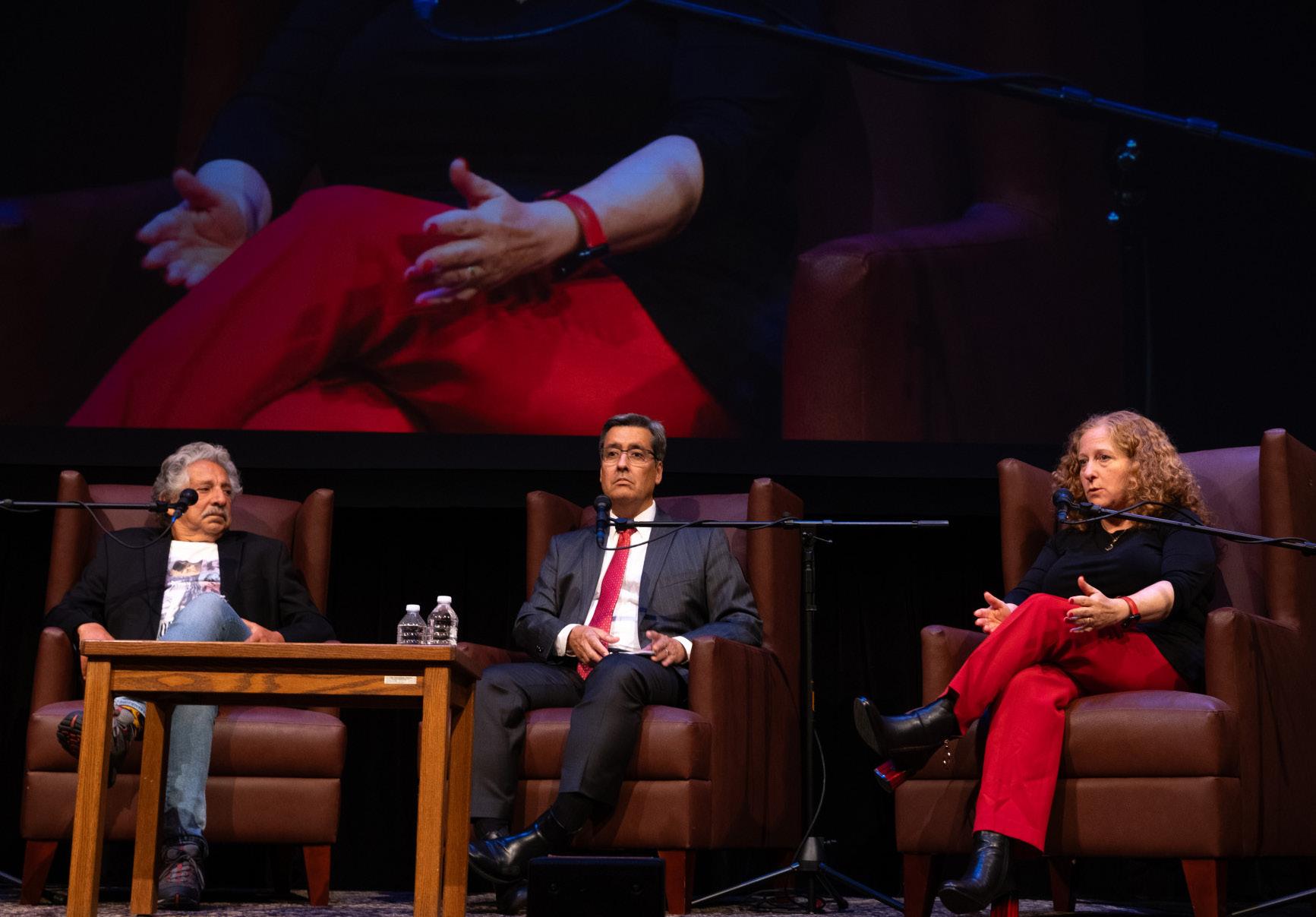
The event, hosted by The Cap Times as part of its weeklong Idea Fest, put free speech center stage as UW-Madison administration continues to face student criticisms of their policies. The discussion, which also included UW-Madison Law School Dean Daniel Tokaji, former Madison Mayor Paul Soglin and moderator David Maraniss, explored the debate between ensuring campus safety and the limits of free speech.
Mnookin said UW-Madison “wants to be a place that supports free inquiry” for faculty and students.
System DEI offices. Vos has pledged to deny system employees pay raises and future funds if the offices aren’t cut.
The university maintains it will not cut DEI programs but instead potentially expand its “umbrella” of DEI programs.
“As a function of the $32 million budget cut, we have not taken any actions focused on DEI and actually, really, we’re looking at ways we can grow what we can do under our diversity umbrella” Mnookin told The Daily Cardinal after the panel.
Free speech a “never-ending battle,” panelists say Soglin, a student activist in the 1960s who was beaten by the police during Vietnam War protests, said the current free speech landscape is “worse than ever” and said there were multiple levels of censorship across academia.
ment” of his free speech lawsuit that challenged UW-Madison’s imposition of overly broad restrictions on students’ free expression.
© 2023, The Daily Cardinal Media Corporation
ISSN 0011-5398
“[It should be] free from influence from me, influence from external forces, from legislators, from parents,” she said.
At the same time, UW-Madison is trying to navigate threats from the Republican-controlled state Legislature, members of which are staunchly opposed to DEI. Assembly Speaker Robin Vos, R-Rochester, said UW System DEI programs are “liberal indoctrination.”
This tension is embodied in the ongoing debate surrounding UW
He became the lead plaintiff in a free speech lawsuit against UW-Madison in 1969. Though speech can be disturbing, Soglin said there can’t be a strict ideological definition on what constitutes permissible speech.
“Hate speech has to be called out, but you cannot maintain free speech for all people if we’re going to have some ideological definition,” Soglin told the Cardinal after the panel. “There are certain types of speech that offend us and therefore, as hateful as it is, unfortunately it has to be allowed in our society.”
During the event, Soglin referred to the “chilling effect,” — a “critical ele-
“Nowadays, that chilling effect comes from so many different sources,” Soglin said, explaining that the effect can come from students making life “miserable and even dangerous” for a visiting campus speaker, pointing to incidents in Boston and California.
“It can come from a legislature, and we know that full well here in Wisconsin over the last several decades of vengeful legislators [saying] ‘we’re gonna cut your budget if you do not [comply],’” Soglin added.
As Mnookin laughed, Soglin dryly asked, “Would you know anything about that?”
“I don’t know of which you speak,”
A key criticism of the administration’s free speech policy is that it fails students of color — a significant minority on campus — who have said they feel unsafe and unlistened to.
These concerns were brought to the forefront last spring when a video of a white UW-Madison student saying violent racial slurs rocked campus and brought renewed attention to the university’s handling of student speech and disciplinary action.
The incident — which Maraniss called “the elephant in the room” — became one of the panel’s focal points when he asked Mnookin how she had responded to the video’s release and the subsequent campus uproar.
Continuereading@dailycardinal.com.
Dane County Board of Supervisors Chair Patrick Miles appointed labor organizer Jay Brower on Tuesday to fill the campus-area District 13 seat vacated by former Supervisor Olivia Xistris-Songpanya.

Xistris-Songpanya resigned from the seat in August, prompting a hearing for candidates seeking to fill the vacant seat until the end of the term in spring 2024. Brower, a labor organizer with SEIU Wisconsin and former professor at Western Connecticut State University, applied to fill the vacancy along with two other candidates: Town of Berry Supervisor Travis Austin and WPS Health Solutions Vice President Sara Redford.
District 13 has a very large student population and encompasses
much of the University of WisconsinMadison campus as well as campusarea housing around the Kohl Center and Camp Randall Stadium.
Brower told The Daily Cardinal he is looking to “connect” his student constituents with the board.
“Universities are the place in our society where new ideas emerge,” Brower said in an email. “Student activism around central political issues is one way those ideas take hold in the mainstream.”
“As I start this position, I certainly think it’s important to engage the campus,” he added.
Brower named criminal justice as a key area of focus and pointed to the board’s search for a new director of the Office of Criminal Justice Reform. The office was created in the county’s 2023 budget to reduce racial disparities in the county’s criminal justice system.
The office’s current director, former Dane County Sheriff Dave Mahoney, ends his term in early 2024. The next director must be qualified to lead the county’s criminal justice reform initiatives, Brower said.
“It’s important that the county hire a director who can bring an interdisciplinary perspective that addresses the breadth of concerns in the criminal justice system that extend well beyond policing,” Brower said.
Brower also stressed the importance of addressing economic inequality in Madison.
“It is obvious to even a casual observer that there is a grossly unequal distribution of wealth in society,” he said. “At the county level, I intend to think carefully about how the tax dollars used to support public initiatives will circu-
late in the county and improve the lives of working people.”
Brower said he intends to run for the District 13 seat in spring of 2024 and has begun collecting the necessary signatures to appear on the ballot.
Miles also appointed candidates to fill two other vacant board seats that opened up after former Supervisors Alex Joers and Mike Bare resigned in August. Verona City Council President Chad Kemp was appointed to represent District 32, which encompasses much of Verona, and former Supervisor Steven Peters will serve as supervisor for District 9, which includes part of west Madison.
Miles said in a press statement he was “pleased” to see multiple “quality candidates” apply to represent each of the three districts.
“I think each person I am
appointing holds views consistent with the incumbent the voters last chose,” Miles said. “I look forward to working with them as we address important issues in the coming budget cycle.”
The board will vote to confirm the appointments Thursday at the County Board of Supervisors meeting.
Among the moving mass of walkers, bikers and bus-hoppers on the University of WisconsinMadison campus is a population of students with disabilities who face difficulties accessing paratransit and accessible shuttle services with ease. This comes with a fearful uncertainty on whether their mobility aid will be kept safe by service providers.
“We’ve seen problems reported from drivers not knowing how to properly load wheelchairs and other mobility aids into their vehicle to drivers being late and students missing classes,” Associated Students of Madison (ASM) Equity and Inclusion Chair Emmett Lockwood told The Daily Cardinal.
According to Lockwood, even general Madison Metro buses like the 80 being equipped with accessibility features still fails to ensure accessibility for students with disabilities.
Specialized accessible shuttle and paratransit services for students with disabilities form the only alternative to the metroaccessible buses and paratransit services on campus. This involves the installation of lifts on Madison Metro buses for riders using wheelchairs, crutches, mobility devices or those who simply need a little help making it onto the bus, according to ASM.
“We think of how packed the 80 [buses] are in the fall between any passing period, and the fact that often students have to push to get onto the 80 bus,” Lockwood said. “For our students who have mobility-related disabilities or sensory-related disabilities, the 80 is broadly inaccessible.”
UW-Madison currently contracts with two accessible transportation services that are exclusive to students with mobility impairment. These services exist as supplements to standard campus bus services, including the 80 series bus routes.
For transit within a limited section of the campus area, the university subcontracts the services of GO Riteway to provide accessible circulator shuttles available after scheduling a ride one hour in advance. While students using Riteway’s accessible shuttle service are not required to certify themselves as eligible, they have until an hour before their desired travel time to make a reservation, according to ASM’s webpage on paratransit details.
On the other hand, the Metro Transit Paratransit Service offers services to non-campus buildings and locations outside Riteway’s shuttle boundary. However, students intending to use this service are required to fill out an application form and then schedule a future in-person assessment.
Regrettably, reserving Metro’s paratransit service necessitates making advance bookings, with a deadline of 4:30 pm on the day before your intended ride, according to ASM’s webpage.
One of the major challenges
with accessible shuttles and paratransit for students on campus is easily accessing their services, let alone finding service reliable enough to accommodate the time commitments they face through the day, according to Lockwood.
“Last spring, I started in the diverse engagement coordinator role, and I started to hear complaints from students who were part of the Disability Cultural Center Coalition. Things like, ‘Hey, I’m late to class today because Paratransit didn’t pick me up,’ or, ‘I’m not sure if I’m able to get to this meeting on time because of paratransit,’” Lockwood said.
Lockwood also noted that another major issue for students with disabilities is the improper securement of mobility aid by accessible circulator shuttle drivers.
“I started to hear about students having problems with drivers not knowing how to use the ramps on their vehicles,” Lockwood said. “A big part of paratransit vehicles is that they
should be able to accommodate students with wheelchairs.”
Brelynn Bille, a senior at UW-Madison and disability rights advocate, started using Riteway’s accessible shuttle service in fall of 2021.
“I had heard some hit-or-miss stories of the shuttle missing rides and not showing up sometimes,” Bille told the Cardinal. “But I wasn’t experiencing that at first. It was actually pretty smooth. Everything was fine, and then when I started using a wheelchair it got a little harder because I started noticing that not all of the drivers were properly trained on securing it.”
Bille, whose first wheelchair of $700 was damaged when riding with Riteway’s accessible shuttle service, also detailed how mobility aids such as wheelchairs are expensive and take time to get processed for insurance.
“You have to use a normal standardized wheelchair for a year before insurance will consider covering a customized one, and we have to wait and do all the different
processes to get approved for it and then actually get measured,” Bille explained. “The whole process took me about 14 or 15 months, so I don’t have that time to do it over again.”
As a paratransit and accessible shuttle user himself, Lockwood also identified how scary it is for students with both short-term and long-term disabilities to see their mobility aid at risk of damage.
“Foldable wheelchairs [or] any mobility aid really cost a lot of money. Many people have to go through insurance to access these aids,” Lockwood explained. “I know for many wheelchair and mobility aid users, our aid getting damaged in any way is our biggest fear.”
As of spring of 2023, Lockwood and ASM set up the first way for students to file complaints about the paratransit and shuttle service they received on campus in a manner that shares information across the various organizations involved in setting up accessible transit on campus.
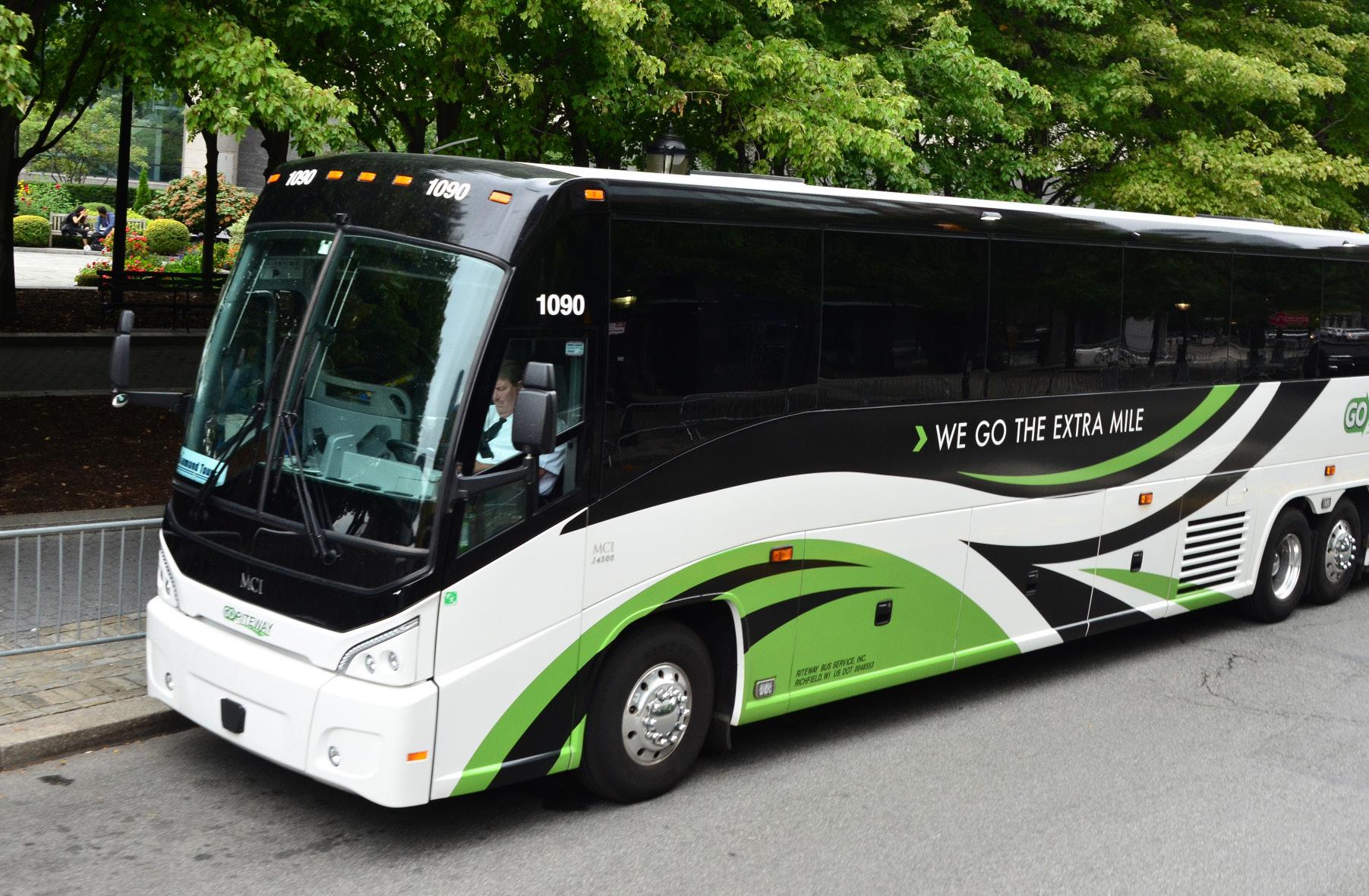
“Before then, ASM was getting complaints, McBurney was getting complaints, Riteway was getting complaints, University Transportation Services was getting complaints and none of us really had a way of sharing them. Now, on the campus paratransit website that explains for students how to use Riteway services, there is also a form where they can report problems,” explained Lockwood.
To voice her issues with how Riteway handled her mobility aid, Billie first reached out to her access counselor at the McBurney Disability Resource Center.
Ultimately, Billie found herself in contact with Riteway’s aid securement trainer, who arrived on-site to monitor the handling of her wheelchair.
“It still feels like if I don’t have one of the two drivers that are very well trained and typically do all of my rides, it’s like I have to coach them through how to secure my wheelchair, or I end up having to file a complaint because they don’t secure it properly,” Billie said.
Ohio voters made headlines in an Aug. 8 special election, prompting questions about Wisconsin’s ballot initiative process — a process in which voters can call for a popular vote referendum.
Ohioans rejected Republican lawmaker-led changes attempting to modify the ballot initiative process by raising the threshold for a ballot initiative’s passage from 50% to 60% approval in future elections.
Generally, a ballot initiative allows voters to invoke a direct vote in an election on proposed laws or constitutional amendments, bypassing the legislative body.
Wisconsin differs from Ohio as the state of Wisconsin does not allow citizen-initiated ballot measures and instead opts for referendums brought to the table by the state Legislature.
This lack of citizen-initiated ballot initiatives only applies to the state level, with one 1914 exception. According to the
Legislative Reference Bureau (LRB), Wisconsin voters don’t have the power to utilize either initiatives or referendums on state ballots, but they can do so in the individual cities that make up the state.
Wisconsin sees far more involvement from citizens through referendums rather than ballot initiatives.
“The [referendum] initiative provides voters with an opportunity to enact laws directly, without involvement of the Legislature or governor. But the question on the ballot requires a yes or no answer,” said Dennis Dresang, professor emeritus of public affairs and political science at the University of Wisconsin-Madison. “The referendum has the same limit, but it is only advisory. A referendum does not enact a law.”
Referendums in Wisconsin are legally necessary when concerning statewide debt, any challenges to existing amendments or if voting rights are being extended to groups of people.
Why Wisconsin has stood
firm in the state’s stance to only utilize referendums in recent years instead of initiatives like other states is “curious,” said Barry Burden, a UW-Madison political science professor.
“It is curious that Wisconsin does not allow direct democracy in the form of ballot initiatives,” Burden said. “The state was at the forefront of the progressive movement more than a century ago that advocated for reforms of this type.”
Referendums in Wisconsin tend to vary across the board in terms of issue. But in the past decade, only three constitutional amendments have been placed on ballots for consideration by the Wisconsin electorate, according to the LRB.
Dane County has recently attempted to utilize the referendum process.
“Recent examples include a vote in spring that recommends that able-bodied people only receive welfare benefits if they are looking for work and another in November 2022 that supports legalizing marijuana for medicinal and recreational use,”
Burden stated. Both referendums fared well with voters. Wisconsin vote #3 on last spring’s ballot regarding “able-bodied individuals and welfare benefits” passed with 79.5% of the statewide vote, and the November 2022 Dane County referendum for marijuana legalization passed among voters with a near equal number of yes votes — 82%.
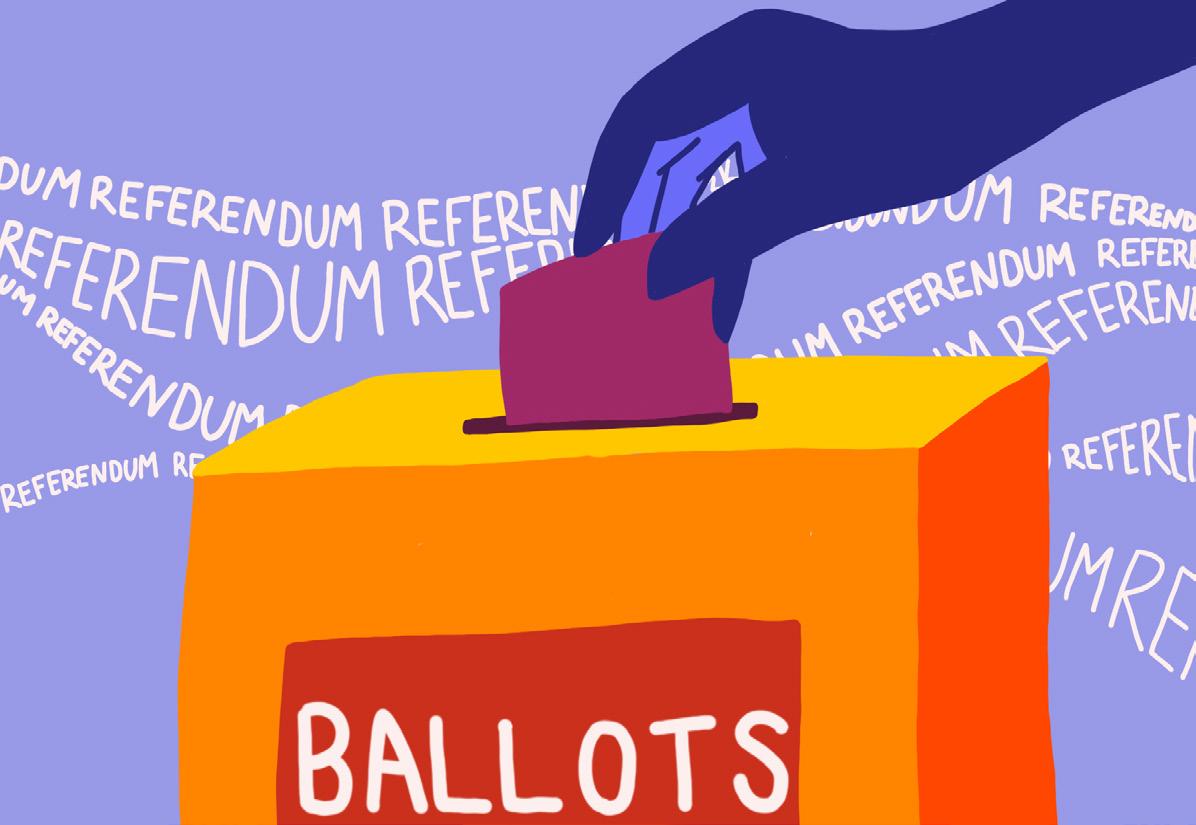
One can look at Ohio’s bal-
lot initiative attempts and question if and how Wisconsin might see changes to its statewide process.
Only time will truly tell the direction that the state of Wisconsin takes when it comes to whether or not a state-wide push for ballot initiatives will be allowed, or if Wisconsinites will continue to attempt to make their opinions heard through referendums instead.
Thousands of students and instructors were informed by email earlier this month that they or at least one student in their course had been enrolled in a data monitoring experiment without the ability to opt out.
The pilot program, Learner Activity View for Advisors (LAVA), notifies advisors of potential patterns of low academic performance. Instructors and students are not allowed to opt out of the program, Vice Provost of Teaching and Learning John Zumbrunnen wrote in an email obtained by The Daily Cardinal.
Approximately 2,800 students are enrolled in the program, according to Zumbrunnen’s email.
The two indicators of potential academic problems are if a student’s grades are in the bottom quartile of the class or if they have an assignment more than five days overdue. A student must have one of these outcomes in two or more classes for it to be flagged by LAVA.
The Department of Information Technology (DoIT) is pioneering this program through its Learning Analytics Center of Excellence (LACE), which aims to use data science to improve UW-Madison students’ learning outcomes.
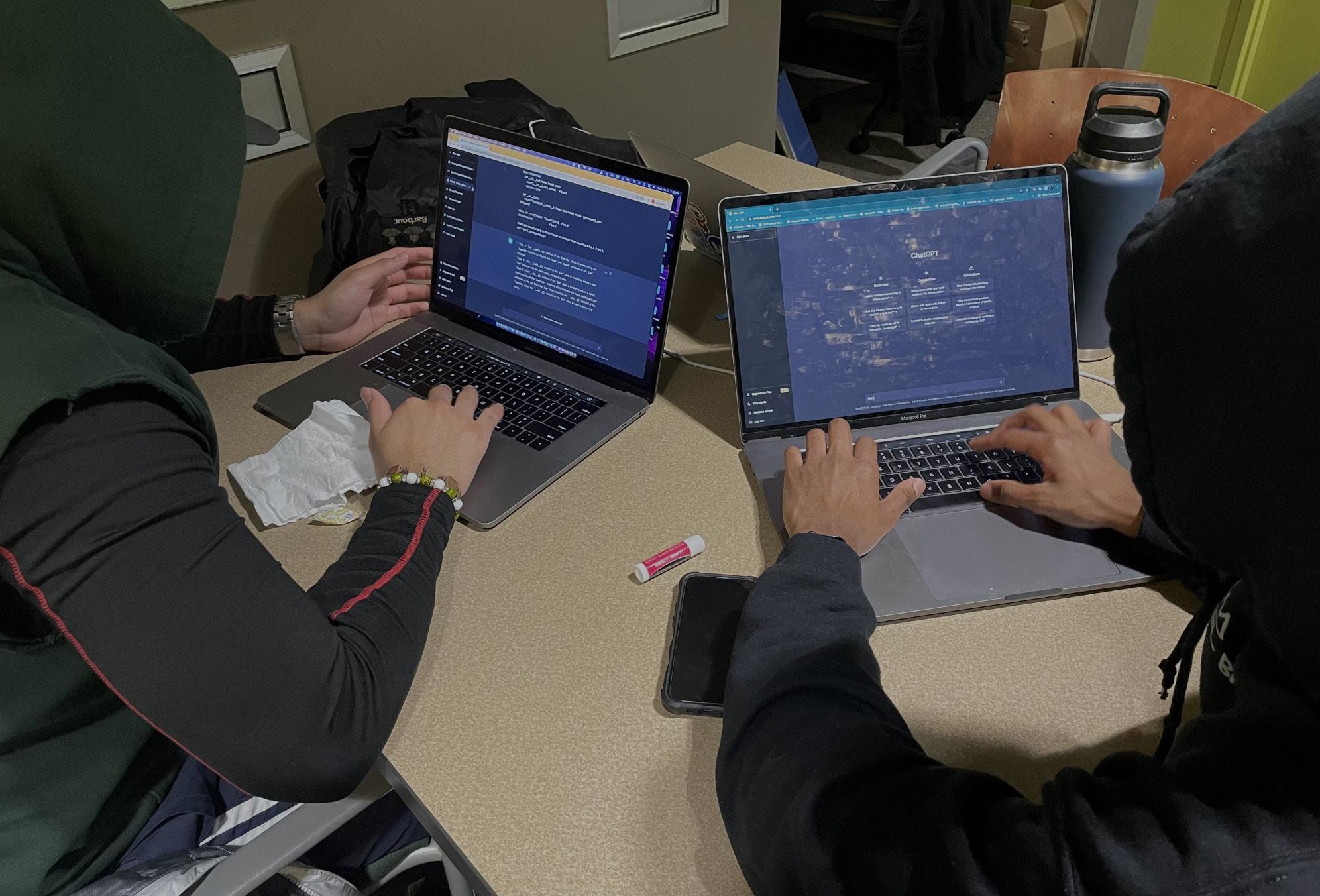
Dorothea Salo teaches several courses related to information security and research involving human-subject data. Salo told the Cardinal she has some concerns over the nature of the program.
“Students want things out of learning analytics. They want to be able to say yes or no,” Salo said. “It looks like students didn’t get a chance to say no here, so I am forced to say that I do not consider this ethical.”
When students enroll at UW-Madison, they consent to the collection and use of their data “to facilitate the operations and educational activities of the University,” according to UW-Madison’s privacy notice.
The privacy notice tells students their data will only be used for “the purposes for which it was collected, unless we reasonably consider that it is needed for another related reason and that the reason is compatible
with the original purpose.”
DoIT told the Cardinal that the purpose of the LAVA program is to help advisors identify students who “may benefit from additional resources to support their academic success.” It does not allow direct access to a student’s assignments or course data, instead showing only highlevel trend indicators.
These aforementioned trend indicators include being in the bottom quartile of a class, something Salo thinks is logistically “pretty ridiculous.” In high-level courses, the bottom quartile would be a small group of students who could well have a B average or better,
she said.
DoIT told the Cardinal that students were not given an option to withdraw from the program because the LAVA project team “worked closely with campus governance groups and relevant authorities for institutional data to ensure that the effort is in accordance with relevant policies, laws and regulations.”
According to Salo, if this program were a study for publication, the university would have to go through the Institutional Review Board because LAVA is “unquestionably” human subjects research.
“But because this is being used internally, there’s less ethi-
cal oversight,” Salo said. “They’re getting away with maybe more than they should be.”
Student records are protected by the Family Education Rights and Protections Act (FERPA), a 1974 piece of legislation that governs educational institutions’ stewardship of student data. The state of data collection and records at the time at which FERPA was introduced was vastly different than it is today, which some researchers have raised concerns with.
In a 2016 publication by two UW-Madison Library and Information Sciences professors, Alan Rubel pointed out that there is a lack of clarity surrounding what FERPA covers today with new technology and monitoring methods.
“Do individual data points count as records or not? That is a big issue,” Rubel said in the paper. “I talk with my undergraduates and they are surprised about how much information is collected about them. I would like to see students made aware, so they can protest, object or decide for themselves what they think about it.”
Salo echoed this sentiment, stating that when she discusses the amount of data collected by the university in her information security classes, “it’s practically always the first time most of the students in my class [have thought about it], and these are people who are self-selecting into an info security course.”
More information about UW-Madison’s learning analytics policies can be found online.
Early last week, students at the University of WisconsinMadison experienced both their first full week of classes of the school year and a three-day-long campuswide internet shutdown.
The two scenarios most definitely do not go hand-in-hand, and the reactions across campus were what one might expect — annoyance, frustration, anxiety or all of the above.
In an age where almost every assignment is completed online and almost every resource is found through the internet, it’s easy to understand how an internet outage would trigger unenthusiastic responses from students and staff. But amidst this forced trip back to a time where computers weren’t the dominant note-taking tool, I also found a good amount of temporary pros.
Without internet, students were forced to be a lot more present. Instead of frantically typing up notes so fast that I wasn’t even fully grasping what a professor was saying, I was able to really listen and take in more of the information.
While completing work between classes, I found myself staying a lot more focused without the luring distractions of my texts coming through my laptop screen or the pull of online shopping drawing me in. With absolutely nothing else loading at all on my devices, my options of what to do were far more limited, which meant that my work and assignments became priority one.
Even just for the typical parts of my day, I found myself having to adjust to a new routine. I’ve become very reliant on my free pass through the university to The New York Times and have grown accustomed to checking it daily to become aware of what’s happening in the world. But without access to my online subscription, I had to read a physical copy of the newspaper.
Despite this change in pace, the information I got out of my daily read was the exact same it would have been if I read it online. In a strange way, the internet shutdown almost encouraged me to look deeper for solutions if a problem arose.
Beyond just being present in classes and with schoolwork in general, the lack of internet forced me and many each other. In one
200-person lecture, we spent the of my friends and classmates to be more present with duration of our class period having a massive discussion on the topic we were learning about rather than just listening to theprofessor speak. A few brave students volunteered their opinions.
Before smaller discussions began, I noticed groups of my classmates, myself included, talking with each other before the TA set out to begin their lesson. Instead of sitting silently on our phones, checking our social media and largely ignoring each other, we were able to connect with one another, a lot more than I’m assuming we would have if we had access to the internet.
The internet shutdown certainly wasn’t something I would say was enjoyable by any means. But it was a harsh awakening to just how much we rely on our devices, and perhaps this reliance is a bit too much.
If anything positive could be spun out of the three-day chaos caused by a lack of internet, perhaps it could be the way students and staff were more present and flexible in their day to day lives.
Five times a year, State Street and Gilman Street are blocked off from traffic and transformed into pedestrian promenades in preparation for the Madison Night Market — or “MNM” for short.

On Downtown Madison’s website, the city claims the night market to be a celebration of Madison’s unique and inspiring creative culture, which it certainly is.
ing student. It has since grown into a full-blown side hustle that Isenberger promotes at local markets and events as well as her retail storefront in Cambridge, Wis.
Although she doesn’t livedowntown anymore, the infectious environment quickly drew her back as a vendor.
“I think [the market] is such a great space,” Isenberger said. “I really love seeing and talking to all the people that come by — you meet so many cool characters.”
weeks old.
In need of additional income to pay off Drax’s medical bills, Blythe claims she “learned to sew to save his life.” But don’t worry — she said Drax is still very much alive and well.
Aside from the social aspect of the market, Blythe saw the event as a way to break into new audiences.
COURTESY ISADORE DANE
I sat down with Isadore “Dizzy” Dane, a Wisconsin native, economics major at the University of Wisconsin-Madison and founder of the local brand Silly Shorts Store.
Silly Shorts Store makes and sells incredibly soft cotton fleece shorts with unique designs that anyone and everyone can be comfortable and happy in.
Inspiration for his shorts comes from a summer spent working at a rafting company in Alaska. A friend made a similar pair of fleece shorts that, while less eccentric, were just as comfortable for all the guides.
Upon returning home, Dane soon realized nothing similar existed in the lower 48. He then brought it upon himself to learn how to sew. After lessons from his mother and countless dedicated hours at the old sewing machine his grandmother gifted him, he successfully crafted his very own pair of fleece shorts.
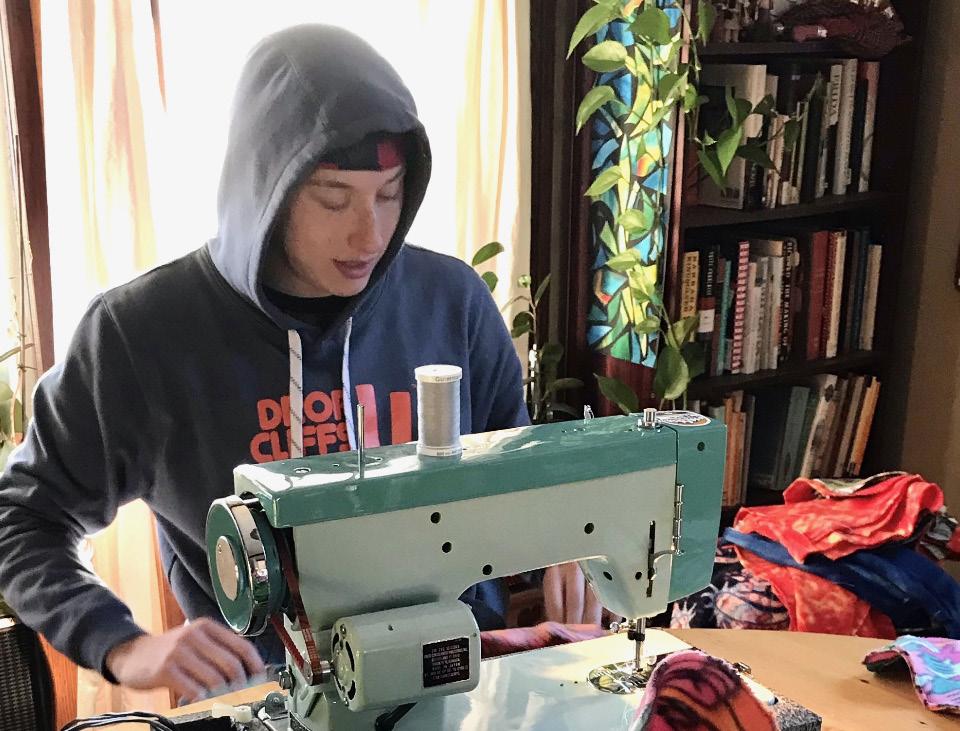
Dane’s shorts went from a side quest for comfort to a profitable business. He made shorts for himself to express his creativity and individu-
ality through each pair. It wasn’t until people started asking where they could get a pair that Silly Shorts Store was born on June 30, 2022.
The company has grown since then. As orders began to exceed Dane’s sewing capabilities, he reached out to a local Madison sewer, whom he met through the Madison Sewers Guild. The two now produce Silly Shorts, and Dane is currently looking to expand the team.
The decision to keep production domestic and local was a conscious choice. Dane is passionate about combatting fast fashion and believes having shorts made ethically and sustainably is a core foundation of the brand and hopes to inspire others to follow suit.
There are aspirations for Silly Shorts Store, namely to expand and have a warehouse with complete production capabilities, to grow the digital side of the business and to focus on content collaboration and events. There are also whispers of a Silly Shorts party on the horizon where a pair of Silly Shorts is required for entry.
Silly Shorts Store is in an exciting phase right now.
Dane was a first-time vendor at the Madison Night Market this past Thursday evening. With a predominantly online market and word-of-mouth sales, Dane said it was beneficial to be able to visually see the market he’s in, compared to his typical sales process.
He described his first public event as “fantastic, with tons of enthusiasm for the project” and exclaimed it “gave [him] lots of ideas on how to move forward.”
Silly Shorts Store will be at the next Madison Night Market on Oct. 19, so make sure to stop by. Expansion to other trade shows, farmers markets and vendor meetups in the upcoming year are also on the horizon.
Given these shorts were born out of an experience in Alaska, I asked Dane how adventure, traveling and his life philosophy have played a role in his brand.
“In terms of traveling and life in general, it’s always good to take risks and put yourself out there,” he said.
“I do believe we are living in a serious world, and by bringing a little bit of silliness into it and differentiating yourself, it can really benefit your character, identity and life experiences.”
Vendors set up shop from 5 p.m to 9 p.m., lining the sides of State Street from the University of WisconsinMadison campus to the Wisconsin state Capitol building in hopes of selling their unique products to locals who flood the thoroughfare.
But to small business owners, the market is more than a lucrative opportunity.
While the variety of handmade items, gifts, art and food are the main attraction for customers, many vendors return to the market for the overwhelming sense of community it brings them.
Entrepreneur Olivia Isenberger is no exception. Her soy candle business, Petal and Wick, began as a passion project three years ago, progressing during her limited free time as a UW-Madison nurs-
Isenberger also uses the market as a networking opportunity and has become fast friends with several of her fellow vendors since beginning to sell at the event a year ago.
Although some vendors have established recurring spots at the Madison Night Market, others are just starting out — like Milwaukee local Staci Blythe, who traveled to Madison to make her MNM debut on Thursday night.
Blythe’s business, “For The Love Of Drax, LLC,” specializes in handmade pet supplies, some of which include patterned bow ties, collars and decorative decals. She started her business to support her rescue dog Drax, who had developed several health issues by the time Blythe adopted him at eight
“Since it’s just me, I can’t put money into marketing like bigger businesses can,” Blythe said. “Coming out here allows me to expand in new areas.”
It’s safe to say Blythe’s first time at the event won’t be her last, despite the lengthy commute.
While it’s special to the area, the market’s diverse attendees and variety of small businesses make clear the event is not just a culmination of Madison’s unique culture but a culmination of Wisconsin’s as a whole. Whether it be the inviting atmosphere, the camaraderie or the handmade products that draw you in, the Madison Night Market truly has something for everyone.
Don’t miss the chance to experience it before the end of the 2023 season. Make sure to head to State and Gilman Streets on Thursday, Oct. 19 between 5 p.m. and 9 p.m. for its final appearance of the year.
Isadore Dane began his business, Silly Shorts Store after his trip to Alaska.Even for Robin Vos and Wisconsin Republicans, this might be a new low.
After months of campaigning in a fraught election for ideological control of the state Supreme Court, liberal Janet Protasiewicz — who campaigned on abortion rights and fair representation — won handily. Her election was a referendum on the abortion issue and 12 years of Republican control, and voters loudly spoke for change. In the most divided state in America, Protasiewicz cruised to a double-digit victory last spring.
In a healthy democracy, the losing party would be reflecting. “How could our views have been so out of touch with the electorate?” they would ask. “Was supporting an abortion statute written over 170 years ago a winning issue?” “Should we really be campaigning with Jan. 6 insurrectionists?”
Of course, healthy democracy and the Wisconsin Republican party do not go hand in hand.
Instead, they charted another course: to keep Protasiewicz from attaining real power and enacting the changes the people of Wisconsin want to see made. Party leaders, including U.S. Sen. Ron Johnson and Assembly Speaker Robin Vos, have said the $9 million she received from the Democratic Party and “rigged” Wisconsin legislative maps make her unable to serve as an impartial judge.
They have called on her to recuse herself. Now, they want to impeach her.
Let’s be clear. This is undemocratic, unprecedented and unwarranted.
The U.S. Supreme Court held in 2002 that judges have the First Amendment right to express their views on legal and political issues while campaigning. In 2017, the Wisconsin Supreme Court ruled judges did not have to recuse themselves from cases involving donors.
Additionally, Protasiewicz’s views on the maps are backed up by every impartial analysis
of the issue. A study done by the Princeton Gerrymandering Project found Wisconsin has “some of the most extreme partisan gerrymanders in the United States.”
Harvard University declared the maps made the state a “democracy desert” with levels of political fairness equivalent to non-democracies such as Bahrain, Jordan and the Congo.
In 2018, Republicans lost every statewide race and earned only 45% of the statewide popular vote, yet they walked away with 64% of the assembly seats.
This skew has emboldened them to make blatant power grabs and disregard the will of the voters.
After two-term Republican former governor Scott Walker lost to current Democratic Gov. Tony Evers in 2018, Vos used the lame-duck period to curb the new administration’s powers. He impaired Evers’ ability to protect the Affordable Care Act and expand infrastructure spending — priorities the Democrats campaigned and won on. Vos had been fine expanding the power of the executive while Walker was governor but changed course when a Democrat took control.
In 2021, he appointed Michael Gableman, who The New York Times called a “ringleader of far-right Republicans’ effort to overturn [Wisconsin’s] presidential results,” to run a 14-month investigation into the 2020 election. The report cited far-right publications such as the Gateway Pundit, spread debunked conspiracy theories and turned up no cases of significant fraud. It will cost taxpayers over $2.5 million.
Just this week, Senate Republicans voted to remove top elections administrator Meagan Wolfe so they could, again, litigate the 2020 election. Election deniers have targeted her with false allegations of widespread fraud for allowing voting in nursing homes during the pandemic and using absentee drop boxes.
To justify removing her, Senate Majority Leader Devin LeMahieu said Wisconsinites
had lost “confidence” in the election process.
“A key component of fair and honest elections is that the electorate have confidence in our elections,” LeMahieu told the Wisconsin Examiner after Wolfe’s failed confirmation vote. “If they don’t have confidence in our elections, we’re disenfranchising voters. They’re not going to go out and vote if they don’t feel that their vote is not going to be stolen or that there’s fraud going on.”
Of course, the only one threatening the election process is his own party. LeMahieu is someone who reappointed a false elector to the Wisconsin Election Board and refused to confirm if Joe Biden won the 2020 election.
All this power and the ability to pull these outlandish stunts, though, rests on the maps. Without them, Republicans might have to engage in the tricky business of appealin-g to voters and winning on their own merits.
With his plan for impeachment in trouble, Vos has tossed one more Hail Mary. He is proposing an independent commission to control the redistricting process without offering many specifics as to what it would look like. The plan was organized in 48 hours, without any opportunity for public comment and few concrete details.
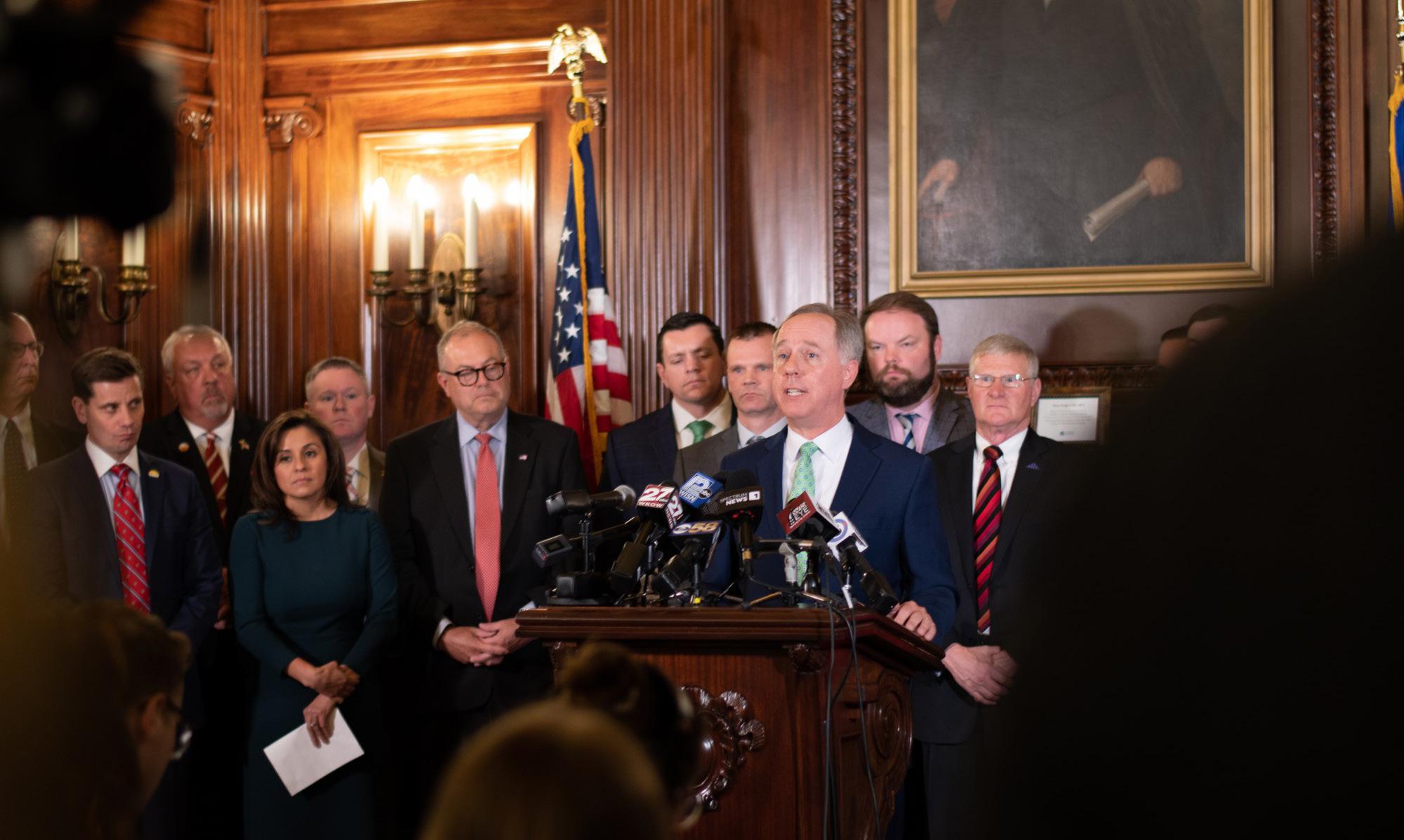
It should be rejected because Vos has no credibility on this issue. He has never shown any interest in good-faith behavior, and it is unreasonable to expect him to start now.
Vos is your little cousin who starts changing the rules of the game when he’s losing. He’ll scream and he’ll whine, but eventually he’ll run out of cards to play. The winds of Wisconsin politics are changing and if his reaction is any indication, they’re set to sweep him to the minority.
Graham Brown is an Opinion editor and junior studying Political Science and History. Do you agree Republicans have put Wisconsin’s democracy at risk? Send all comments to opinion@ dailycardinal.com
With the first two weeks of the semester under each student’s belt, it’s that time of year when students dread receiving those pristine white envelopes under their front doors, declaring their fate — also known as their rent renewal agreement.
The choice between scrambling for a new place to live or renewing an overpriced apartment lease with no amenity upgrades shouldn’t sound so difficult, but for the students at the University of Wisconsin-Madison, it can be one of the most overwhelming decisions to make all school year.
With a record-breaking number of students enrolled at UW-Madison, housing options and availability are limited.
Returning students at the university are aware of the incredibly early start to the leasing process in Madison. In fact, some apartments have already reached full capacity while others are slipping away each day.
The most frustrating ordeal in the upcoming 2024-25 leasing year is the surge in rent prices. Almost every Madison apartment complex has increased their rent upward of $200, citing inflation as a cause.
The pricing increases have been the deciding factor for many students who choose not to resign their lease.
UW-Madison sophomore Isra Ahmed, whose four-bedroom apartment at the X01 Apartments located at 1001 University Ave. will increase around $225 per month, decided to seek out other housing options for next year.
“One of my roommates and I will be looking for another apartment next year,” Ahmed said. “We just can’t justify the price any longer.”
X01 is a central hub for students at UW-Madison, with close proximity to the majority of campus. However, the lack of luxury amenities made Ahmed question whether or not the rent price was worth it.
“It’s not affordable by any means when compared to other apartments like The Hub or The James. They’re similar in pricing but not in amenities,” Ahmed said.
The Hub On Campus Madison, owned by Greystar, is known as a luxury apartment for students on campus. Amenities include an on-site gym, pool, hot-tub, sauna, study lounge and cold plunge area for residents. With a monthly rent ranging from $1,080$2,100, there is no shortage of grandeur living.
An apartment in Madison that is deemed both inhabitable and “affordable” is no longer feasible. Common student apartment complexes such as The Embassy or Equinox start prices at $1,200 and $1,365 for a one-bedroom apartment, respectively.
The number of freshmen who are currently enrolled at the UW-Madison fell by 7.8% compared to the 202223 academic year, according to university officials. But the decrease in first-year students has not affected the rent price surge.
The competition between students to sign a lease for an apartment first has gotten out of hand. Last fall, potential residents waited hours in line for housing options that were deemed “affordable.” Due to students likely signing their leases in early October, they’re faced with the decision to forgo stylish housing at an astronomical price for something more affordable, outdated or not well-maintained.
Wisconsin has no cap on how much a tenant’s rent can be increased, with an exception for individuals living in income-restricted housing. A Wisconsin state statute also limits local governments from putting caps on rent, limiting local power to regulate housing price increases.
Whether you reside in the heart of downtown, on-campus or 30 minutes away, living in Madison is becoming increasingly unaffordable.
Will the university step up to address the housing crisis UW-Madison students are living through? The yearly apartment olympics has no shortage of competitors, with each year increasing the burden that falls on students.
Hana Razvi is a junior studying Journalism and Strategic Communication. Do you agree that students are being priced out of Madison? Send all comments to opinion@dailycardinal.com
The struggle to find affordable housing in Madison is at an all time high.
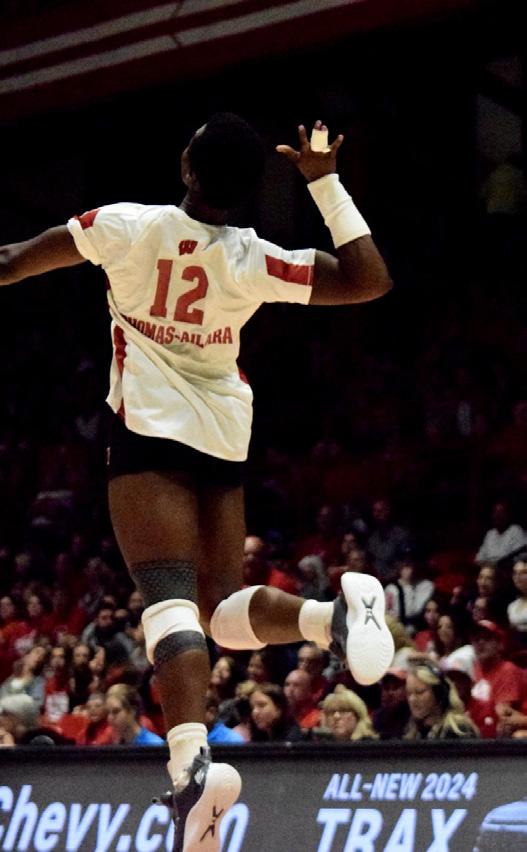
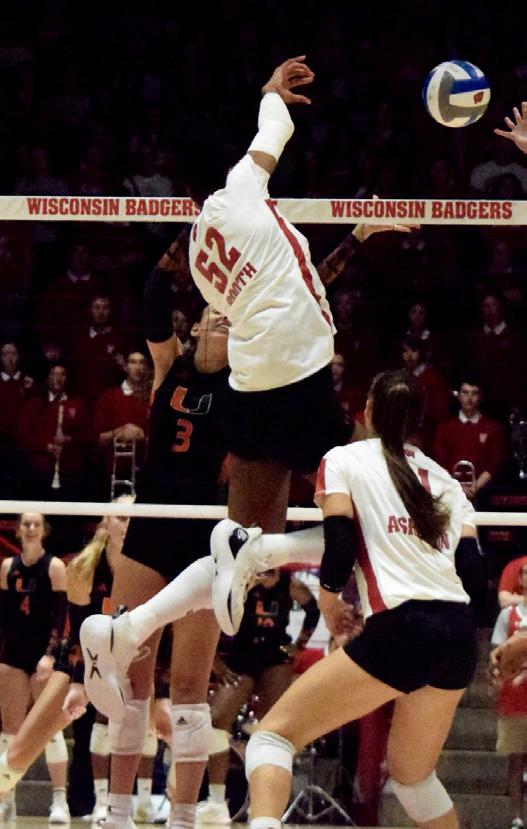 By Dylan Goldman SENIOR STAFF WRITER
By Dylan Goldman SENIOR STAFF WRITER
The No. 1 Wisconsin Badgers traveled down to Gainesville, Florida, and earned a 3-2 win against the No. 3 Florida Gators in what proved to be their most pulsating victory yet.
The Wisconsin Badgers hosted the Georgia Southern Eagles on Saturday in front of a home crowd of 75,610 at Camp Randall Stadium.
The Badgers found themselves in familiar early-game woes, with Braelon Allen only mustering four carries for 16 yards. The newly adopted Air Raid offense continued to struggle with just 95 passing yards in the first half — most of those yards coming from just two plays.
The Badgers continued to play sloppy offense, resulting in several three-and-outs and frustrating illegal shift penalties that prevented them from gaining any meaningful momentum. The score was knotted at 7-7 as the halftime whistle blew.
The Badgers exhibited a mix of reliability and inconsistency on defense in the first half. They only allowed 7 points and escaped tight spots several times, either due to errant throws by Eagles quarterback Davis Brin or missed opportunities, including a failed field goal attempt by Eagles kicker Michael Lantz at halftime that kept the game level.
The second half began much like the first, with the Badgers sputtering to a three-and-out on their first drive. They planned to go for it on 4th and 1, but an illegal shift penalty pushed them back by 5 yards, forcing another punt.
The Eagles seized the momentum on the ensuing drive, partially thanks to a contested catch by Joshua Thompson between two Badgers cornerbacks that propelled them to the 25-yard line. A 25-yard reception by Jjay Mcafee put the Eagles ahead 14-7.
The turning point arrived when Allen sprinted for a 32-yard gain deep into Eagles territory. He plunged over the goal line three plays later with a 4-yard touchdown run to tie the game.
From there, the Badgers never looked back. Their defense stepped up significantly, forcing three consecutive turnovers — including two
interceptions and a fumble recovery.
The defensive line began to pressure Brin more while the secondary contested passes more effectively.
The Badgers’ offense also caught fire, scoring touchdowns on three consecutive drives. A glimpse of the Air Raid offense emerged with a 45-yard pass to Badgers tight end Hayden Rucci in the middle of the fourth quarter, followed by a 17-yard reception by transfer wide receiver CJ Williams.

All five touchdowns Saturday came on the ground — true to Wisconsin’s style — thoughTanner Mordecai managed to accumulate 236 passing yards and complete 19 of 30 passing attempts.
Allen had a stellar game, racking up 94 yards and two touchdowns, while Chimere Dike led the Badgers in receiving with 57 yards.
On the Eagles’ side, Brin threw for an impressive 383 yards but struggled with five interceptions. Derwin Burgess Jr. was the top receiver with eight receptions for 124 yards. Surprisingly, the Badgers’ offense ended up with fewer total yards and first downs than the Eagles, but Georgia Southern’s turnovers ultimately cost them the game.
Defensively, the Badgers dominated with six sacks and seven tackles for loss. Darryl Peterson stood out with two sacks and three tackles for loss, while Hunter Wohler contributed with one sack, one tackle for loss and two interceptions.
Wisconsin and adjustments:
The Badgers struggled to start strong in their games this season so far. They were tied at halftime against Georgia Southern, trailed by 15 against Washington State and only had a small four-point lead over Buffalo. It’s not easy to win games when you’re playing catchup in the second half.
But the good news is that Wisconsin has a knack for making smart changes during halftime. They scored 14 more points than Buffalo, 13 more than Washington
State and 14 more than Georgia Southern in each third quarter. If the Badgers can start the first half stronger while keeping up their third-quarter success, they could become a dominant team.
Secondary liabilities:
Despite Wisconsin’s historical reputation for producing exceptional defensive front-seven talent and running the ball effectively, their secondary has been a consistent concern this year. Miscommunications among Badger cornerbacks Saturday allowed Eagles wide receivers to make significant plays.
Instances like a 16-yard catch on 3rd and 11 by Khaleb Wood, a 27-yard catch on 3rd and 6 by Dalen Cobb and a remarkable 68-yard catch by a double-covered Joshua Thompson highlighted the need for improvement in the secondary. These lapses must be addressed to ensure a more robust defensive performance moving forward.
Running game trumps Air Raid:
Wisconsin is still a running back school, and Braelon Allen is still the engine to this offense.
The Wisconsin offense stalled in the first half. Allen only had four rushes for 16 yards, and Mellusi wasn’t any better. The Badgers offense picked up when Allen started running the ball better, opening up space for Mellusi and Mordecai to start making plays.
Head coach Luke Fickell had a great passing playbook at Cincinnati, Phil Longo did incredible things with star QB Drake Maye at the University of North CarolinaChapel Hill last year and Tanner Mordecai broke passing records at SMU. But even with all these new additions to Wisconsin, what works best for this offense is running the ball.
The Badgers face an uncommon Friday night lights game later this week against Purdue in West Lafayette at 6 p.m..
Wisconsin has faced plenty of tests this season, but they have not pushed as hard as they did Sunday afternoon. The Gators, who defeated Wisconsin in another five-set thriller last year at the Kohl Center, had the Badgers on the ropes quickly. The first set was initially close with the scoreboard showing a tie of 10-10. Florida took the lead on the next point and never looked back. They secured the first set 25-15, condemning the Badgers to a sort of lopsided defeat they are not used to seeing.
The second set was more closely contested. Wisconsin trailed 23-22 but handed the second game to the Gators courtesy of two attack errors. Facing a 2-0 hole, Wisconsin was dangerously close to suffering their first loss of the season.
But like they have in previous games against SEC opponents Arkansas and Tennessee, the Badgers had a response.
Determined to at least avoid a sweep, Wisconsin started the third set with a commanding 14-4 advantage. Florida cut the lead to three, but it was too late as Wisconsin reached match point and won the third set with a kill from Anna Smrek, who ended with a team-high 16 kills.
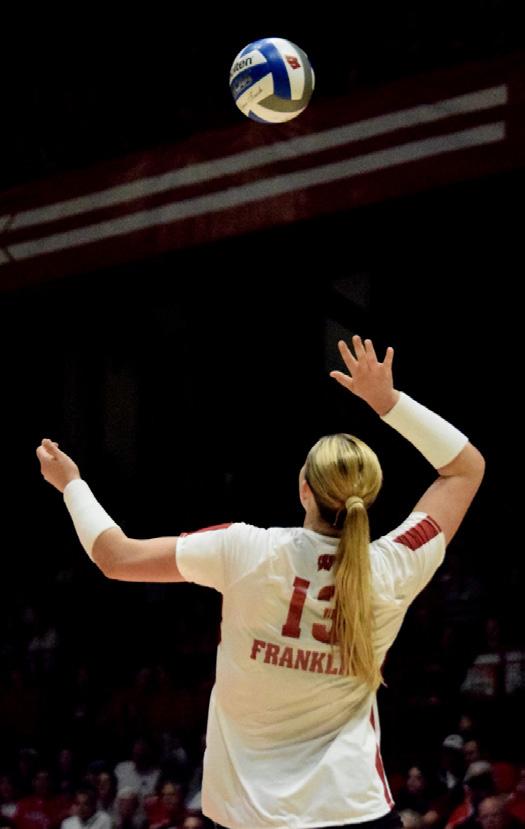
The fourth set was more competitive, and the Badgers reached match point with the score reading 24-20. A service error from CC Crawford and an error from Smrek closed the gap to 24-22. However, Smrek immediately made up for her mistake and registered another set-ending kill to bring the Badgers into a winnertake-all fifth set.
Wisconsin trailed 10-8 in the fifth set, but their championship mettle kicked in. The Badgers went on a 5-0 run to take a 13-10 lead. Another kill from Smrek would later give Wisconsin a 14-11 lead, setting up match point.
The Gators used a kill and an ace to make Badger fans nervous, but the Badgers triumphed for a reverse sweep comeback.
Inevitably, Smrek was there once again with the clutch kill to end the set and match, giving Wisconsin arguably their most exciting win to date this season.
The Badgers came back from 0-2 for the first time since 2018 and avenged last season’s loss to the Gators, who they were 1-6 against all-time before today.
Wisconsin now has five ranked wins to their credit before Big Ten play starts this week.
Coach Kelly Sheffield was pleased with his team’s resilience,
saying after the game, “We gotta keep getting better. It’s an important win, on the road. Being able to come in and [the] whole place is against you. Battling back when you’re not playing well and playing a cleaner version of the game,” he said after Saturday’s match. “Defensively, they are really good. Mentally they can really get to you. Real credit to our players. We battled and we fought. Most of the match was played in the mud.”
The Badgers had a tough slate of non-conference games, but the real gauntlet begins with the start of their Big Ten schedule. They will kick off the conference season with a trip to Evanston to face Northwestern on Friday night at 7 p.m.

The boys of the Sun Room proved feel-good rock ‘n’ roll isn’t dead as they took to Madison’s Majestic Theatre with a refreshing yet classic sound.

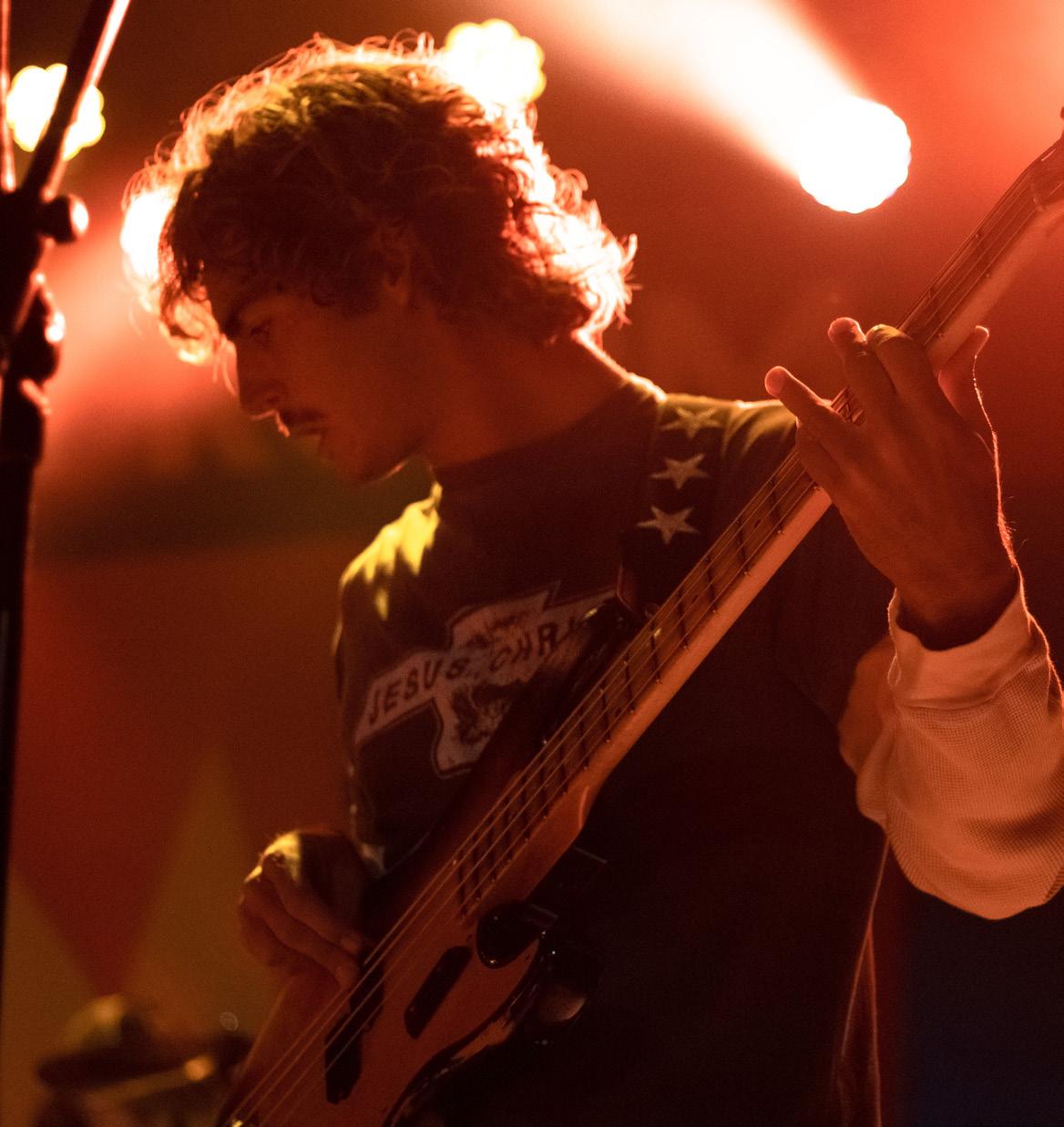
With sandy, grown-out hair, lead singer Luke Asgian, lead guitarist Ashton Minnich and bass guitarist Max Pinamonti kicked off their North American tour Monday night with a setlist equally as bright-eyed and energetic as the crowd before them.
The University of Wisconsin-Madison’s Homecoming celebration is next week, and two free and fun art events are coming up for students to experience.

This Saturday, Sept. 30, UW-Madison will host Armani White and D.A.R.S at Varsity Hall in Union South. This event will be free for students, but tickets will need to be reserved using a valid Wiscard before the event.
The homecoming after-party on Saturday, Oct. 6 will feature two local bands, the Periodicals and Boxing Day. Both of these groups will be having a free concert on Library Mall after the homecoming parade.
Boxing Day’s members are all UW-Madison students. They include bassist Jan Grzywacz, trumpeter
Ella Scott trumpet, drummer Shayfer Huitt, guitarist Annika Maxey and vocalist and guitarist Christopher Norcross. Boxing Day was named the winner of the Wisconsin Union Directorate Battle of the Bands in the spring of 2023. The band has played multiple shows in the campus area since winning the $300 prize.
The Periodicals are a Wisconsin-based band that combines multiple genres — including northern soul, classic R&B and alternative rock. The Periodicals are a ten-piece band featuring guitars, horns, keyboards, violin and sensational vocals. They most recently released a new set of live recordings in May of this year.
These concerts are just some of the events that are part of UW Homecoming celebrations. More details can be found at union.wisc.edu.
The tour follows the release of their recent extended play (EP), “Outta Their Minds,” and is the group’s second North American tour. Sun Room also opened last year for wellknown bands like the Inhalers and Louis Tomlinson.
Sun Room gained popularity for their revitalization of the ‘60s surf sound aided by the algorithmic success of TikTok, which helped establish a fanbase eager for a new take on a classic sound.
Although they looked the part and sang vocal harmonies very reminiscent of the ‘60s surfer style, Sun Room’s sound felt more rebellious than their predecessors. Their new EP leans into the sound of college-age garage rock.
The sound is still clean and groovy but incorporates edgy guitar licks and heartracing tempos.
This combination of a drum-forward, big guitar sound was refreshing and proved just how into the music these boys were. They used each other’s sound to play off one another, and the crowd mirrored their passion.
The band leaned heavily into the musicality that often flourishes in small, closeknit college bands and mimicked the styles such bands have perfected during house shows or garage concerts.
Sun Room’s energy is very youthful, so much so that it’s difficult to believe that they’ve found a sensible way to combine grunge and surf sound. But they do, bringing something up-and-coming to the music scene.
The music was heartfelt, and Sun Room’s performance truly illustrated the personal connection the artists have to their music. It’s easy for newer musicians to fall back on clichés when talking about adolescence, growing up and navigating the adult world, but Sun Room manages to create a down-to-earth performance that demonstrates the carefree spirit of young adults today.
The boys played confidently but didn’t take themselves too seriously. They were there to connect with fans and have fun, which is essentially what their EPs
are all about: being able to let go once in a while and experience the joys of being young.
Sun Room’s sound evokes nostalgia for summers gone by, the weeks leading up toward school or late nights driving with your friends. Windows down, stereo up and laughs all around.
Such ideas struck a chord with the college-aged crowd surrounding Sun Room as they opted to spend their Monday night enjoying the last few moments of summer and their young adult lives before being swept into the craziness of life after school.
Playing with smiles all through the night, Sun Room might’ve had a vintage vibe. But Monday night’s performance took a modern approach to the surf genre while reminding fans that authenticity and sheer talent still exist in the music world today.